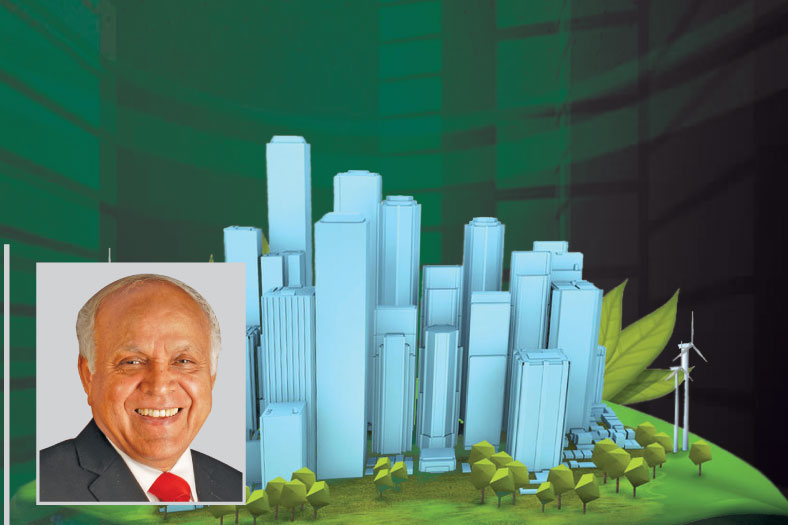Be green or you would be out
Be green or you would be out
“Every building doesn’t need to be platinum or gold, but it has to be green,” said legendary architect Karan GroverAn architect has a very major role to play in the entire process of building, not just drafting a well-organised plan. Well-known architect Karan Grover, in an exclusive interview with Subhajit Roy, shared his ideology of being an architect, the importance of a regulatory body as well as his plans to promote green building.
As a trendsetter in this field, could you please enlighten our readers on the current state of the architecture profession in India?Let me start by talking about the role of architect in today’s economy. You have heard about global warming and climate change. The biggest problem today and tomorrow will be the lack of energy and the supply of energy. We have abused the earth and taken it for granted.
In the US, a simple family will have five cars: one for husband, one for wife, one for elder child, one for second child, and one for guest. So for them five cars in a single family is nothing new. Few years back in Baroda, I met a German couple who had two children. Whenever I had travelled to their place, I used to get presents for their kids as at that time we had no children. On one occasion when I went to their house and walked around the house, I saw nine air conditioners were switched-on and nobody was there. So I thought they might have gone out for the evening. The next day morning, I went again and found nobody. Their house was on the way from my home to office and for 7 days there was nobody. When they came back, I asked about their whereabouts and came to know that they were in Germany for 3 weeks keeping all the air conditioners on. On enquiring why they left their AC on they replied that the house becomes too hot when they come back. They didn’t care – that’s their lifestyle, and we think it’s fashionable to copy that lifestyle.
Currently, I am doing a project of a 300-apartment building. I thought there would be two cars per apartment, but the client told me that there would be one car for every bedroom. So there are six bedroom apartments in that building which means one is expected to have six cars.
Today, buildings use 50 per cent of the energy, more than what transportation and industry use. Green buildings would be able to save 50 per cent; that means architect can affect 25 per cent of the world’s energy. Fifty or 60 per cent of the world is going to become urban by 2030. Around 70 per cent of the buildings that India needs by 2030 are yet to be built, whereas all the buildings that America needs for 2030 are built. It shows how much an architect is required in this whole process. An architect has a very major role to play. The other role he has to play is the idea of promoting green. When President Clinton came in India in 2000, he said in the next 10 years this would become mandatory: if you are not green, sooner or later, you would be out. How right he was.
Today many jobs are being awarded to foreign architects. What are the reasons? Are our architects not competent enough for handling such projects?We always had this fascination about western culture that anything from them is better than us which is not true. Buildings in the west have always appeared to be better because of their access to different materials. Once, Anil Ambani told me that he has studied in America; although I was a great architect, he wanted to get an American architect. So there is this fascination. They will take anything from the foreign architects. The architects from abroad are getting 16-18 per cent fees while we are struggling with 5 per cent. Explain that to me, how is that happening? If you talk about FSI or even built-up cost, they don’t know those details that are vital to our economy.
We were working with an international architect the other day, and I said this building looks expensive. He said that he was a concept architect and not aware of the project cost. Today if our buildings cost `11 more per square feet, we have to sit for 3 days to answer it. So I think there must be some system which we don’t have it with the counsel, architectural fraternity, IIA, or IIID. I cannot go and practice in America, so there must be some rules that when a foreign architect comes to India, he must have 49 per cent and the Indian colleague must have 51 per cent etc., but that is a different story. We must get our act together. We ourselves are not together and some architects hero worship these foreign architects. My point is here that we should have some kinds of regulatory body — a system for foreign architects which becomes mandatory.
Some of architects in India are taking up construction job to earn more money, your comments.I disagree with the idea of architect becoming a contractor because I think there is a conflict of interest. Being an architect, I am supposed to see that contractor does justice for my design for my client. If an architect becomes contractor, how is it going to help? My fee is 5 per cent and the contractor’s commission is 15 per cent, so he would make more money out of contracting than architecture. It is a very confused role. I think that professionally and ethically, we are not allowed to get into the business of architecture. If I am making carpets, I want to use my carpets whether it is good or bad. Technically you cannot build in India if you are not an architect. Here, some people are building without architects, but this is not allowed. Only 5 per cent of the buildings in the world are built by the architects. People don’t think they need to employ an architect. The architect’s fees are based on what you spend. The more you spend, the more is the architect’s fees. In fact, the reverse should be the norm — the more I save, the more money one should give me because my fees are very small compared to the project cost.
Brief us about green buildings for sustaining nature. In green buildings, the savings are incredible. In our buildings, we are saving 62 per cent energy. Our buildings are based on 100 per cent day lights. The savings are enormous: 50 per cent water, 100 per cent day light, and 62 per cent energy. In many cities in India, the power cut is more than 8 hours a day. I am able to cool 11 C without air conditioner but with the help of a wind tower. Obviously, if you have an air conditioner which cools from 29-23 C, the compressor is used a little. For 40-23 C, the compressor is used all the time.
I am on a panel for sustainability. Today we have the National Building Code, ECBC, and IGBC for green buildings. My fight with the government is to make these norms mandatory. Every building doesn’t need to be platinum or gold, but it has to be green.
Having so many codes in place, isn’t it difficult to make them mandatory when the real estate sector is largely unorganised?The sector may be unorganised but the permitting authorities such as municipal commissioners and architects are organised. Architects who design the master plan are not unorganised. So making the green norms mandatory is not difficult.
How do you find the use of glass in today’s architecture?Glass is an incredible material and can connect you to the outside. However, any material used badly is a bad material.
Today, is the job of an architect restricted to building designing only?No, an architect has to build the entire environment: building cities, planning towns, infrastructure, etc.
But don’t you think, there are only very few architects who think of the environment while conceptualising a project?That is because our education is at fault. Our education has become very narrow minded, and I keep telling my students that you must think beyond the building. I think the understanding of what and who, and the role of an architect has been misunderstood because we don’t have good architects. If you have great architects, you will have incredible environment that makes you feel happy and where you love to work.
Our former President Dr A. P. J. Abdul Kalam came to our Green Building Centre in Hyderabad, and he said that the building seemed to make everyone happy. I asked him how he could make such a statement. He replied that he could see it, and everyone was feeling well which was apparent.
Is there any immediate need to review our educational system when it comes to architectural profession?I think the entire system needs a revamp. Today in the AICTE, the apex body of technical education, nobody even realises the importance of sustainable buildings. Our complete education is western based. I know everything about the Italian columns, but I don’t know anything about chajja, aangans, nalukettu, and courtyards. So everything is wrong with the system, but we are not strong enough to change it. We need a group to sit down and strategise a new curriculum for architecture. A curriculum which embraces India, embraces sustainability, and exposes us to our own vernacular, context, and roots.
Recently, there were few accidents of flyover collapsing in Surat, Kolkata etc. Is it anyhow related to architectural designing?No, it’s a part of structure. These are all because somebody is trying to cut corners. In these projects, there is corruption: somebody removes reinforcement and some structural engineer or contractor brought down shuttering 3 days before because they wanted to make money. It has nothing to do with the architecture; it’s all structure. Every bridge has a structural designer and contractor, and it’s the corruption by both.
Our education has become very narrow minded, and I keep telling my students that you must think beyond the building. I think the understanding of what and who, and the role of an architect has been misunderstood because we don’t have good architects. If you have great architects, you will have incredible environment that makes you feel happy and where you love to work.
7
Cookie Consent
We use cookies to personalize your experience. By continuing to visit this website you agree to our Terms & Conditions, Privacy Policy and Cookie Policy.







